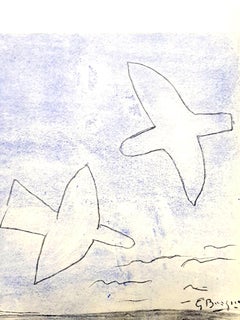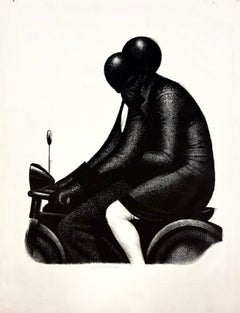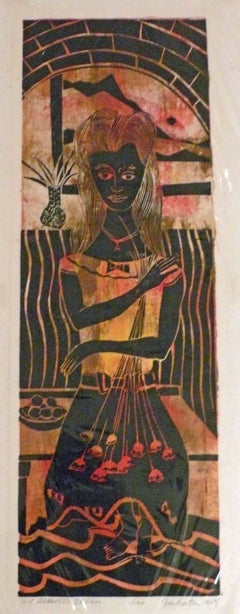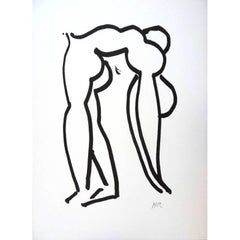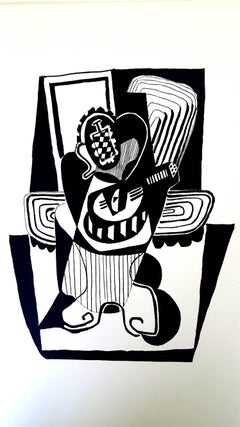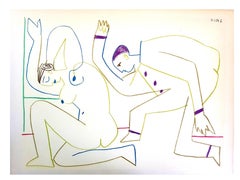1950s Figurative Prints
to
1,182
1,748
291
171
55
33
Overall Width
to
Overall Height
to
1,056
273
257
121
80
68
22
17
16
4
4
2
244
58
55
50
47
3,530
7,599
25,383
6,837
292
597
1,410
1,238
1,331
2,298
3,257
5,180
2,834
1,340
3,027
1,758
522
11
1,518
950
856
581
510
383
367
299
188
102
93
92
77
75
66
57
52
46
40
39
1,567
381
148
120
84
124
551
1,379
777
Period: 1950s
After Georges Braque - Oiseaux - Pochoir
Located in Collonge Bellerive, Geneve, CH
after Georges Braque
Oiseaux
Color Pochoir on Paper
Published in the deluxe art review, XXe Siecle (issue number 11 "Les nouveaux rapports de l'art et de la nature")
1958
Dimensions:...
Category
Modern 1950s Figurative Prints
Materials
Stencil
MOTO
Located in Portland, ME
Hirsch, Joseph. MOTO. Cole 20. Lithograph, 1950. 18 1/2 x 16 1/4 inches; 470 x 413 mm. Edition of 75, signed in pencil. Printed on Arches paper by Gaston Dorfinant, Paris. A fine imp...
Category
1950s Figurative Prints
Materials
Lithograph
$2,500
MY BELOVED'S DREAM
Located in Portland, ME
Barton, John Murray. MY BELOVED'S DREAM. Color Woodcut, 1959. Edition of 100. Titled, numbered 1/100, signed and dated in pencil. 23 5/8 x 7 3/4 inches (image), 11 1/2 x 27 inches (s...
Category
1950s Figurative Prints
Materials
Color, Woodcut
after Henri Matisse - Acrobat
Located in Collonge Bellerive, Geneve, CH
after Henri Matisse - Acrobat
Edition of 200
with the printed signature, as issued
76 x 56
With stamp of the Succession Matisse
References : Artvalue - Succession Matisse
Category
Modern 1950s Figurative Prints
Materials
Lithograph
Pablo Picasso (after) Helene Chez Archimede - Wood Engraving
Located in Collonge Bellerive, Geneve, CH
Pablo Picasso (after)
Helene Chez Archimede
Medium: engraved on wood by Georges Aubert
Dimensions: 44 x 33 cm
Portfolio: Helen Chez Archimede
Year: 1955
Edition: 240 (Here it is on...
Category
Cubist 1950s Figurative Prints
Materials
Lithograph
The Human Comedy - Lithograph
Located in Collonge Bellerive, Geneve, CH
after Pablo Picasso - The Human Comedy - Lithograph
Signed and dated in the plate
Dimensions: 32 x 24 cm
This artwork is a lithograph in colors on wov...
Category
Modern 1950s Figurative Prints
Materials
Lithograph
L' aretino
Located in Roma, IT
Original print. Black and white etching hand signed lower right. Titled lower left. Signed and date on the plate "Bartolini 1959". Edition of 50 prints.Very good conditions except li...
Category
Modern 1950s Figurative Prints
Materials
Etching
La Comédie Humaine
Located in OPOLE, PL
Pablo Picasso (1881-1973) - La Comédie Humaine
Lithograph from 1954.
Dimensions of work: 35.5 x 26.5 cm
Publisher: Tériade, Paris.
The work is in Excellent condition.
Fast and s...
Category
Modern 1950s Figurative Prints
Materials
Lithograph
The Human Comedy - Lithograph
Located in Collonge Bellerive, Geneve, CH
After Pablo Picasso
The Human Comedy - Lithograph after an original drawing, as published in the journal "Verve"
Printed signature and date
Dimensions...
Category
Modern 1950s Figurative Prints
Materials
Lithograph
Liberté j’écris ton nom.
Located in New York, NY
Éluard, Paul. Liberté j’écris ton nom. Paris (Seghers), [1953].
Folding broadside (leporello), with continuous color silkscreen by Fernand Léger, integrated with text, extending th...
Category
Cubist 1950s Figurative Prints
Materials
Screen
Pietro Consagra - Composition - Original Etching
Located in Collonge Bellerive, Geneve, CH
Pietro Consagra - Composition - Original Etching
1959
Dimensions: 32 x 24 cm
From the art review XXe siècle
Unsigned and unumbered as issued
Category
Surrealist 1950s Figurative Prints
Materials
Etching
Henri Laurens - Character - Original Lithograph
Located in Collonge Bellerive, Geneve, CH
Marino Marini - Character - Original Lithograph
1951
Dimensions: 32 x 24 cm
From XXe siècle
Unsigned and unumbered as issued
Category
Surrealist 1950s Figurative Prints
Materials
Lithograph
"A Poem in Each Book" Exhibition Poster
Located in Collonge Bellerive, Geneve, CH
Exhibition poster for "A Poem in Each Book" by Paul Eluard, illustrated by his friends the painters-engravers, at Maison de la Pensée Française, Paris, October 26 - November 11, 1956...
Category
Cubist 1950s Figurative Prints
Materials
Lithograph
Jean Cocteau - Immortal Goat - Original Lithograph
By Jean Cocteau
Located in Collonge Bellerive, Geneve, CH
Original Lithograph by Jean Cocteau
Title: Immortal Goat
Signed in the plate
Dimensions: 38 x 28 cm
Edition: 200
1958
Jean Cocteau
Writer, artist and film director Jean Cocteau was...
Category
Modern 1950s Figurative Prints
Materials
Lithograph
Le Taureau Blanc, Surrealist Etching by Lucien Coutaud
Located in Long Island City, NY
Lucien Coutaud, French (1904 - 1977) - Le Taureau Blanc, Year: 1957, Medium: Etching, Image Size: 7.75 x 5 inches, Size: 13 x 10 in. (33.02 x 25.4 cm), Description: From the collec...
Category
Surrealist 1950s Figurative Prints
Materials
Etching
The Human Comedy - Lithograph
Located in Collonge Bellerive, Geneve, CH
After Pablo Picasso
The Human Comedy - Lithograph after an original drawing, as published in the journal "Verve"
Printed signature and date
Dimensions: 32...
Category
Modern 1950s Figurative Prints
Materials
Lithograph
(after) Sonia Delaunay - Composition - Pochoir
Located in Collonge Bellerive, Geneve, CH
(after) Sonia Delaunay - Composition - Pochoir
1956
Dimensions: 32 x 25 cm
Revue XXe Siècle
Cahiers d'art published under the direction of G. di San Lazzaro.
Unsigned and unumbered ...
Category
Abstract Geometric 1950s Figurative Prints
Materials
Stencil
Jean Cocteau - Christ - Original Handsigned and Handcolored Lithograph
By Jean Cocteau
Located in Collonge Bellerive, Geneve, CH
Jean Cocteau - Christ - Original Handsigned and Handcolored Lithograph
Signed in the plate
Handsigned and dated in color pencil.
Handcolored in pencil.
Dimensions: 50.5 x 33 cm
1957
...
Category
Modern 1950s Figurative Prints
Materials
Lithograph
The Human Comedy - Lithograph
Located in Collonge Bellerive, Geneve, CH
A stone lithograph on Vélin de Rives paper after a drawing by Spanish artist Pablo Picasso (1881-1973) titled "La Comedie Humaine", 1954, unsigned as issued. From "Verve", no. 29-30,...
Category
Modern 1950s Figurative Prints
Materials
Lithograph
Wassily Kandinsky (after) - Small World - Lithograph
Located in Collonge Bellerive, Geneve, CH
Wassily Kandinsky (after) - Small World - Lithograph
Conditions: excellent
32 x 24 cm
1952
From the art review XXe siècle, San Lazzaro
Unsigned and unumber...
Category
Abstract Geometric 1950s Figurative Prints
Materials
Lithograph
after Henri Laurens - Cubism - Pochoir
Located in Collonge Bellerive, Geneve, CH
after Henri Laurens - Cubism - Pochoir
Published in the deluxe art review, XXe Siecle
1956
Dimensions: 32 x 24 cm
Publisher: G. di San Lazzaro.
Unsigned and unumbered as issued
Category
Modern 1950s Figurative Prints
Materials
Stencil
Jean Cocteau - Three Persons or One - Original Lithograph
By Jean Cocteau
Located in Collonge Bellerive, Geneve, CH
Original Lithograph by Jean Cocteau
Title: Three Persons or One
Signed in the plate
Dimensions: 32 x 25.5 cm
Edition: 200
1959
Publisher: Bibliophiles Du Palais
Unnumbered as issued
Category
Modern 1950s Figurative Prints
Materials
Lithograph
Inspired Village of Montmartre - Pochoir
Located in Collonge Bellerive, Geneve, CH
(after) Maurice Utrillo
Inspired Village of Montmartre
Pochoir with printed signature
Edition of 490
Dimensions: 39 x 30 cm
Information : This print was created for the portfolio "Le Village inspiré, Chronique de la bohème de Montmartre (1920-1950) " published by Vertex in 1950
Condition : Excellent
Maurice Utrillo (1883 - 1955)
The French painter Maurice Utrillo was born as the illegitimate son of the painter Suzanne Valladon in Paris on December 26, 1883. He was adopted by the Catalan art critic Miguel Utrillo...
Category
Modern 1950s Figurative Prints
Materials
Stencil
Cinq Poésies en Hommage à Georges Braque (Five Poems in Homage to Georges Braque
Located in Palo Alto, CA
Georges Braque Cinq Poésies en Hommage à Georges Braque (Five Poems in Homage to Georges Braque), 1958 is the image Braque designed for the cover of a book containing five poems by R...
Category
Modern 1950s Figurative Prints
Materials
Lithograph
Jacques Villon - Man - Original Etching
Located in Collonge Bellerive, Geneve, CH
Jacques Villon - Man- Original Etching
1951
Signed in pencil and numbered
Dimensions : 34.8 x 25 cm
Category
Modern 1950s Figurative Prints
Materials
Etching
Pablo Picasso (after) Helene Chez Archimede - Wood Engraving
Located in Collonge Bellerive, Geneve, CH
Pablo Picasso (after)
Helene Chez Archimede
Medium: engraved on wood by Georges Aubert
Dimensions: 44 x 33 cm
Portfolio: Helen Chez Archimede
Year: 1955
Edition: 240 (Here it is on...
Category
Cubist 1950s Figurative Prints
Materials
Engraving
"Noel, " Religious Linocut in Green on Tan Paper signed by Sylvia Spicuzza
Located in Milwaukee, WI
"Noel" is an original linocut in green ink on tan paper by Sylvia Spicuzza. The artist stamped her signature lower center. This artwork features the Virgin Mary holding the baby Jesu...
Category
American Modern 1950s Figurative Prints
Materials
Linocut
Angel
Located in Missouri, MO
Angel, 1952
Ferol K. Sibley Warthen (American, 1890-1986)
Color Woodblock Print
6.5 x 5 inches
16 x 13.75 inches with frame
Signed Lower Right
Titled Lower Left
Born 1890, Died 1986...
Category
American Modern 1950s Figurative Prints
Materials
Color
Zoran Music (after) - Composition - Pochoir
Located in Collonge Bellerive, Geneve, CH
Zoran Music (after)- Composition - Pochoir
1959
Dimensions: 32 x 24 cm
From the art review XXe siècle
Unsigned and unumbered as issued
Category
Surrealist 1950s Figurative Prints
Materials
Etching
Jean Cocteau - Woman's Profile - Original Lithograph
By Jean Cocteau
Located in Collonge Bellerive, Geneve, CH
Original Lithograph by Jean Cocteau
Title: Profil
Signed in the plate
Dimensions: 65 x 44 cm
Category
Surrealist 1950s Figurative Prints
Materials
Lithograph
Domergue - Sublime - Original Signed Lithograph
Located in Collonge Bellerive, Geneve, CH
Original Lithograph by Jean-Gabriel Domergue
Title: Sublime
Signed in the plate
Dimensions: 40 x 31 cm
1956
Edition of 197
This artwork is part of the famous portfolio "La Parisienne...
Category
Impressionist 1950s Figurative Prints
Materials
Lithograph
Marc Chagall - The Bible - Original Lithograph
By Marc Chagall
Located in Collonge Bellerive, Geneve, CH
Marc Chagall, Original Lithograph depicting an instant of the Bible.
Technique: Original lithograph in colours
Year: 1956
Sizes: 35,5 x 26 cm / 14" x 10.2" (...
Category
Modern 1950s Figurative Prints
Materials
Lithograph
Domergue - The Dancer - Original Lithograph
Located in Collonge Bellerive, Geneve, CH
Original Lithograph by Jean-Gabriel Domergue
Title: The Dancer
Signed in the plate
Dimensions: 40 x 31 cm
1956
Edition of 197
This artwork is part of the famous portfolio "La Parisie...
Category
Impressionist 1950s Figurative Prints
Materials
Lithograph
Jean Cocteau - The Boxer - Original Lithograph
By Jean Cocteau
Located in Collonge Bellerive, Geneve, CH
Original Lithograph by Jean Cocteau
Title: The Boxer
Signed in the plate
Dimensions: 32 x 25.5 cm
Edition: 200
1959
Publisher: Bibliophiles Du Palais
Unnumb...
Category
Modern 1950s Figurative Prints
Materials
Lithograph
after Jean Dubuffet - Flowers - Pochoir
Located in Collonge Bellerive, Geneve, CH
after Jean Dubuffet - Flowers - Pochoir
1957
Dimensions: 32 x 25 cm
Edition: G. di San Lazzaro.
From the art review XXe siècle
Unsigned and unumbered as issued
Category
Modern 1950s Figurative Prints
Materials
Stencil
The Human Comedy - Lithograph from "Verve"
Located in Collonge Bellerive, Geneve, CH
After Pablo Picasso - The Human Comedy - Lithograph from the journal "Verve"
Signed and dated in the plate
Dimensions: 32 x 24 cm
Printed by Mourlot, Paris.
Pablo Picasso
Picasso i...
Category
Modern 1950s Figurative Prints
Materials
Lithograph
Paul Jouve - Chimpanzee - Original Engraving
By Paul Jouve
Located in Collonge Bellerive, Geneve, CH
Paul Jouve - Chimpanzee - Original Engraving
Editions Rombaldi, Paris, 1950.
Copy on velin creme de Rives
Artwork by Paul Jouve.
Original copper engraving ...
Category
Modern 1950s Figurative Prints
Materials
Engraving
Jacques Villon - Two Cubist Vases - Original Etching
Located in Collonge Bellerive, Geneve, CH
Jacques Villon - Two Cubist Vases - Original Etching
1950
Signed in pencil
Edition of 40
Jacques Villon (1875 - 1963)
Jacques Villon was born Gaston Duchamp on July 31, 1875, in Da...
Category
Modern 1950s Figurative Prints
Materials
Etching
The Human Comedy - Title Page - Lithograph
Located in Collonge Bellerive, Geneve, CH
After Pablo Picasso
The Human Comedy - Lithograph after an original drawing, as published in the journal "Verve"
Printed signature and date
Dimensions: 32 x 24 cm
This ...
Category
Modern 1950s Figurative Prints
Materials
Lithograph
Domergue - Parisienne - Original Signed Lithograph
Located in Collonge Bellerive, Geneve, CH
Original Lithograph by Jean-Gabriel Domergue
Title: Parisienne
Signed in the plate
Dimensions: 40 x 31 cm
1956
Edition of 197
This artwork is part of the famous portfolio "La Parisie...
Category
Impressionist 1950s Figurative Prints
Materials
Lithograph
Midnight Madness - Witches on Night Flight
Located in Miami, FL
Pioneering female illustrator Gwenda Morgan creates an exuberantly complex image of a squad of broom-riding - pointed-hatted witches with black cats in tow. They fly through an inky black moonlit sky and are witnessed by only a rooftop owl. With the simple means of black and white, Morgan has rendered a highly charged composition that pluses with electricity. The whole image is on the cusp of being abstract while being representational. It is brilliantly designed with great attention to detail and is evocative of a sorcerer's malignant powers. Unframed. not signed
Printed from the original block as part of the suite of 8 prints that accompanied the limited edition book Diary of a Land Girl, Whittington Press, 2000. The suite of prints was included with the first 50 copies of the book, and a further 8 suites were printed, from which this print comes.
Gwenda Morgan (1 February 1908 – 1991) was a British wood engraver. She lived in the town of Petworth in West Sussex.
Early life
Morgan was born in Petworth, her father having moved there to work at the ironmongers, Austen & Co, of which he later became proprietor. He was the son of a Welsh-born military farrier.
Education
Following school in Petworth and at Brighton and Hove High School, Morgan, studied at Goldsmiths' College of Art in London from 1926. From 1930 she attended the Grosvenor School of Modern Art in Pimlico where she was taught and strongly influenced by the principal, Iain Macnab. The Grosvenor School was a progressive art school and the championing of wood engraving and linocuts fitted with its democratic approach to the arts.
Works
Morgan was commissioned to illustrate a number of books published by private presses. For the Samson Press she produced the frontispiece for Duke Hamilton...
Category
Contemporary 1950s Figurative Prints
Materials
Woodcut
François Desnoyer - Free Child - Handsigned Original Lithograph
Located in Collonge Bellerive, Geneve, CH
François Desnoyer - Free Child
Original Lithograph
Handsigned
Dimensions: 38 x 28 cm
François Desnoyer was a French visual artist who was born in ...
Category
Post-Impressionist 1950s Figurative Prints
Materials
Lithograph
Percy Drake Brookshaw Linocut of Marching Band Brugge (on grey)
Located in London, GB
To see our other original Modern British Art, scroll down to "More from this Seller" and below it click on "See all from this Seller".
Percy Drake Brookshaw (1907-1993)
Marching Ban...
Category
Modern 1950s Figurative Prints
Materials
Linocut
after Jean Dubuffet - Personnage - Pochoir
Located in Collonge Bellerive, Geneve, CH
after Jean Dubuffet
Personnage
Pochoir on paper
1956
Dimensions: 32 x 25 cm
Edition: G. di San Lazzaro.
From the art revue XXe siècle
Unsigned and unumbered as issued
Category
Modern 1950s Figurative Prints
Materials
Stencil
Geo Ham - The Shooting Star - 1956
By Geo Ham
Located in Saint Ouen, FR
Geo Ham - The Shooting Star
Lithography
Paper size : 76x56cm
Size of work : 53x34cm
1956
900€
Category
1950s Figurative Prints
Materials
Paper
Fishing - Signed Drypoint - Chinese, French Abstarct Art
By Zao Wou-Ki
Located in London, GB
ZAO WOU-KI 1921- 2013
Beijing 1921 - 2013 Switzerland (Chinese)
Title: Fishing La pêche, 1951
Technique: Original Hand Signed and Numbered Drypoint on Wove Paper
Paper size: 25 x...
Category
Abstract 1950s Figurative Prints
Materials
Drypoint
CIEL GRIS II
Located in Aventura, FL
Hand signed & numbered by the artist. Lithograph in colors on Rives paper. HC edition. Sheet size 19 x 13 inches. Image size 8.75 x 3.5 inches. Custom framed as pictured. Maeght...
Category
Abstract 1950s Figurative Prints
Materials
Paper, Lithograph
$3,000 Sale Price
25% Off
The Triumph of Medicine Il trionfo della medicina - Italian Art, Lithograph
Located in London, GB
GIORGIO DE CHIRICO 1888-1978
Vólos, Greece 1888 - 1978 Rome (Italian)
Title: The Triumph of Medicine Il trionfo della medicina, 1953
Technique: Original Hand Signed and Numbered Li...
Category
1950s Figurative Prints
Materials
Lithograph
Jean Cocteau - The Voice - Original Lithograph
By Jean Cocteau
Located in Collonge Bellerive, Geneve, CH
Original Lithograph by Jean Cocteau
Title: The Voice
Signed in the plate
Dimensions: 32 x 25.5 cm
Edition: 200
1959
Publisher: Bibliophiles Du Palais
Unnumbered as issued
Category
Modern 1950s Figurative Prints
Materials
Lithograph
Domergue - Dark Hair Lady with a Scarf - Original Lithograph
Located in Collonge Bellerive, Geneve, CH
Original Lithograph by Jean-Gabriel Domergue
Title: Dark Hair Lady with a Scarf
Signed in the plate
Dimensions: 40 x 31 cm
1956
Edition of 197
This artwork is part of the famous por...
Category
Impressionist 1950s Figurative Prints
Materials
Lithograph
Domergue - Elegant Couple - Original Signed Lithograph
Located in Collonge Bellerive, Geneve, CH
Original Lithograph by Jean-Gabriel Domergue
Title: Elegant Couple
Signed
Dimensions: 40 x 31 cm
1956
Edition of 197
This artwork is part of the famous...
Category
Impressionist 1950s Figurative Prints
Materials
Lithograph
The Entrance to the Peaceful Kingdom, Modern Woodcut by Martin Barooshian
Located in Long Island City, NY
Artist: Martin Barooshian, American (1929 - )
Title: The Entrance to the Peaceful Kingdom
Year: 1951
Medium: Woodcut, signed in pencil
Edition: 30
Size: 12 x 18 inches
Category
Modern 1950s Figurative Prints
Materials
Woodcut
Le French Can Can from La Ville
Located in New York, NY
This lithograph by Fernand Leger is from the portfolio entitled "La Ville" (The City) which consists of 29 lithographs featuring scenes of people, life and emotions of Paris. The art...
Category
Modern 1950s Figurative Prints
Materials
Lithograph
Ciel Gris I (Gray Sky I), 1959
Located in Palo Alto, CA
Utilizing straight lines and sharp angles, Braque creates geometric shapes reminiscent of folded origami. The true identities of these geometric forms elude us, though they vaguely r...
Category
Modern 1950s Figurative Prints
Materials
Lithograph
$8,000 Sale Price
33% Off
Rupert Rides by Orovida Pissarro - Animal etching
Located in London, GB
*UK BUYERS WILL PAY AN ADDITIONAL 20% VAT ON TOP OF THE ABOVE PRICE
Rupert Rides by Orovida Pissarro (1893-1968)
Etching
31 x 23.5 cm (12 ¼ x 9 ¼ inches)
Signed and dated lower righ...
Category
Post-Impressionist 1950s Figurative Prints
Materials
Etching
Nu Bleu II
Located in London, GB
Lithograph in colours based on the cut-out of the same title, 1952
From 'Verve' Magazine Volume IX, Nos 35 & 36: 'Dernières Oeuvres de Matisse 1950-54'
Pr...
Category
Modern 1950s Figurative Prints
Materials
Lithograph
Le nid vert (The Green Nest), 1950
Located in Palo Alto, CA
The bird is Georges Braque's calling card. When the 70-year-old artist was commissioned to create monumental decorations for the Louvre, he chose the bird as his subject. This winged animal appears again and again in his oeuvre, but its representation is noteworthy in this print. To those who would say that Braque is not a draftsman, Dora Vallier writes, "for [him], drawing is not a means of giving outward appearance to forms but of showing what lies within." Along the same lines, Braque himself says, "Forget things, only remember their relationship." These two statements encourage thoughtful viewing.
Coming back to its nest and hatched egg, a great black bird is hardly visible against the dark green of its home and the brown leaves behind. Rather than spend time on the details, Braque emphasizes the spatial arrangement of the scene. Everything is compressed down to one level; the curtain of heart-shaped leaves blends together as it falls toward the nest. Braque sees how the tree, nest and bird interrelate, and this entwined relationship is what he chooses to show.
Created circa 1950, this original color etching is hand-signed by Georges Braque (Argentueil, Val-d'Oise, 1882 - Paris, 1963) in pencil in the lower right margin and numbered 281/300 in pencil in the lower left margin. The edition was printed by Atelier Krommelinck, Paris on Rives paper, and published by Maeght, Paris.
Catalogue Raisonné:
Georges Braque The Green Nest (Le nid...
Category
Modern 1950s Figurative Prints
Materials
Etching
$6,500 Sale Price
23% Off
Bareback Act, Old Hippodrome
By Gifford Beal
Located in Missouri, MO
Gifford Beal (1879-1956)
"Bareback Act, Old Hippodome" 1950
Lithograph
Signed Lower Right
With original Associated American Artists label verso
image: 6 3/8 x 9 5/8 in. (16.2 x 24.6 cm)
sheet: 12 x 16 in. (30.4 x 40.6 cm)
framed: 17 x 20 in.
Gifford Beal, painter, etcher, muralist, and teacher, was born in New York City in 1879. The son of landscape painter William Reynolds Beal, Gifford Beal began studying at William Merritt Chase's Shinnecock School of Art (the first established school of plein air painting in America) at the age of thirteen, when he accompanied his older brother, Reynolds, to summer classes. He remained a pupil of Chase's for ten years also studying with him in New York City at the artist's private studio in the Tenth Street Studio Building. Later at his father's behest, he attended Princeton University from 1896 to 1900 while still continuing his lessons with Chase. Upon graduation from Princeton he took classes at the Art Students' League, studying with impressionist landscape painter Henry Ward Ranger and Boston academic painter Frank Vincent DuMond. He ended up as President of the Art Students League for fourteen years, "a distinction unsurpassed by any other artist."
His student days were spent entirely in this country. "Given the opportunity to visit Paris en route to England in 1908, he chose to avoid it" he stated, "I didn't trust myself with the delightful life in ParisIt all sounded so fascinating and easy and loose." His subjects were predominately American, and it has been said stylistically "his art is completely American." Gifford achieved early recognition in the New York Art World.
He became an associate member of the National Academy of Design in 1908 and was elected to full status of academician in 1914. He was known for garden parties, circuses, landscapes, streets, coasts, flowers and marines. This diversity in subject matter created "no typical or characteristic style to his work."
Beal's style was highly influenced by Chase and Childe Hassam, a long time friend of the Beal family who used to travel "about the countryside with Beal in a car sketching...
Category
American Realist 1950s Figurative Prints
Materials
Lithograph
Picador debout avec son cheval et une femme (Picador, Woman, and Horse), 1959
Located in Palo Alto, CA
Considered to be one of Picasso’s monumental linoleum prints, Pablo Picasso Picador debout avec son cheval et une femme (Picador, Woman, and Horse), 1959 is a large-scale artwork that captures the essence of this artist’s innovation and minimalist creativity. His simple lines curve and undulated together to form the characters of the piece: the woman – feminine and robust, the horse – whimsical and characteristic, and the picador – strong and masculine. All three subjects create a triad composition making way for a harmonious and balanced piece. The entire work exudes an air of femininity and mystery, all set against a backdrop of a misty grey helping to create Picasso’s sensual environment of intrigue.
Created in 1959, Pablo Picasso Picador debout avec son cheval et une femme (Picador, Woman, and Horse) is a color linocut on Arches paper hand-signed by Pablo Picasso (Malaga, 1881 – Mougins, 1973) in pencil in the lower right margin. Numbered 21/50 in pencil in the lower left margin, this work was printed by Arnéra, Vallauris and published by Galerie Louise Leiris, Paris.
Catalogue Raisonné:
Pablo Picasso Picador, Woman, and Horse (Picador debout avec son cheval et une femme), 1959 is fully documented and referenced in the below catalogue raisonnés and texts (copies will be enclosed as added documentation with the invoices that will accompany the sale of the work):
1. Baer, Bridgette. Picasso Peintre-Graveur, Tome V – Catalogue Raisonné de l’œuvre grave et des monotypes, Berne: Editions Kornfeld, 1989. Listed and illustrated as catalogue raisonné no. 1238.
2. Bloch, Georges. Picasso Catalogue de l'ouvre gravé et lithographié, Volume I. Kornfeld et Cie: Switzerland, 1968. Listed and illustrated as catalogue raisonné no. 913.
3. Boeck, W., intr. Pablo Picasso Linoleum...
Category
Modern 1950s Figurative Prints
Materials
Linocut
$34,000 Sale Price
24% Off
Le Signe (The Sign), 1954
Located in Palo Alto, CA
Braque Le Signe (The Sign), 1954 is an intricate and mysterious piece. This work comes from a period in Braque’s life in which he became considerably more in...
Category
Modern 1950s Figurative Prints
Materials
Lithograph
$7,000 Sale Price
33% Off
Recently Viewed
View AllMore Ways To Browse
Kim Tschang Yeul
Tom Blackwell On Sale
Tom Everhart Lithograph
Torii Kotondo
Victor Richardson
Vintage Boulangerie Signs
Vintage Les Nereides
Vintage Meat Scales
Vintage Multiplier Reel
Warhol Northwest Mask
Whistler Fumette
Yoko Ono Lithograph Harold Town
Zeno Giglietti
Ak47 Lotus
Alex Katz Bicycle
Alex Katz Christy
Alex Katz Twilight
Alex Katz Wedding Dress
